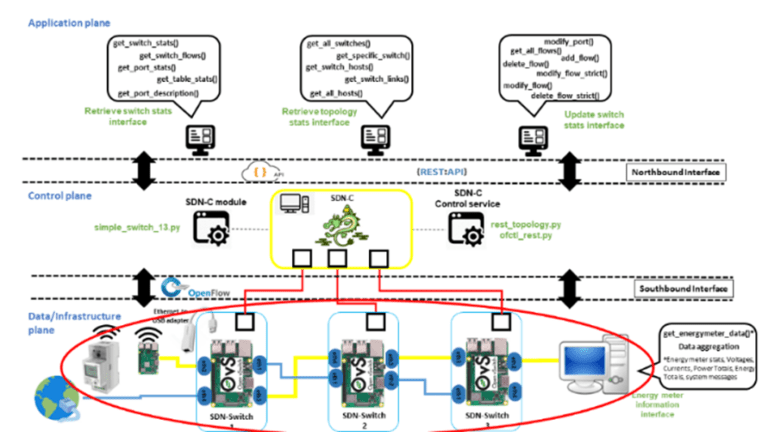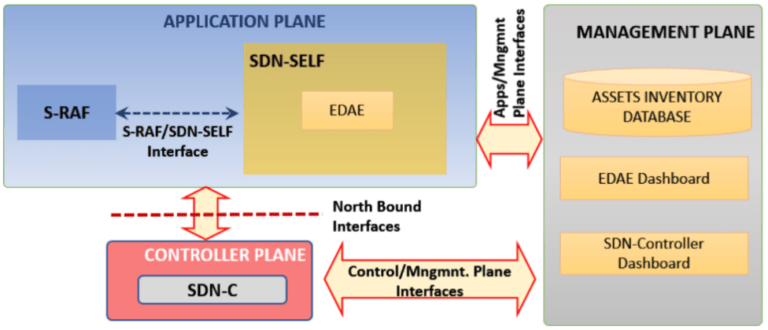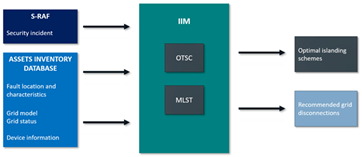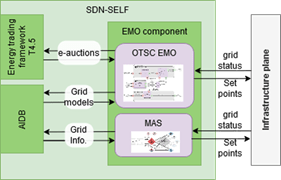The fourth work package on the SDN-microSENSE project, led by IREC, has finished providing several tools to fit in the SDN-SELF layer. This layer oversees creating applications to reduce and mitigate the effects of a threat. More precisely, this layer is composed by Measurement and Control Unit Switching framework (MCUS), Electric Data Analysis Engine (EDAE), the Islanding and optImisation fraMework (IIM), the rEstoration Machine-learning framewOrk (EMO) and the Blockchain-based Energy Trading System (Block).
Several tools have been developed to address the SDN-SELF layer needs. These tools intend first to integrate it with all the interconnections and then evaluate it in the different project use cases to prove its functionalities.
Measurement and Control Unit Switching framework (MCUS)
More than a single architectural block, the MCUS is a specific SDN-microSENSE framework which makes use of different functional blocks and infrastructure elements in its architecture: the SDN-Controllers (in the Controller Plane), and the SDN-Switches, Measurement Units (PMUs and Meters) and RTUs in the Infrastructure Plane.
MCUS components integrate the fundamental pillar of SDN technology into the EPES ecosystem. Therefore, the SDN applications of the WP4 can significantly enhance the entire EPES operation, mainly the cybersecurity sector. The performed works have specified how the SDN technology can evolve the conventional EPES devices turning them into SDN-enabled EPES, providing numerous capabilities that can optimise the security and extend the functionalities using other SDN Applications. This controller has evolved the original version of Ryu, a centralised app, into a redundant system with multiple Ryu controllers, avoiding the single point of failure due to an EPES anomaly or cyberattack. Finally, a custom OpenFlow pipeline on SDN switches would facilitate the management of the flow entries and maximise the utilisation of the hardware resources.


Electric Data Analysis Engine
The EDAE is a component that maximises the observability and the QoS of the communication network. EDAE is not only rearranging the communication path network but also deciding the data paths based on the risks of the assets in the electrical grid and information of the network switches. In other words, the EDAE reroute the communication paths considering the electric elements, maintaining the electric system informed the overall status. This component also uses the EPES component and other tools developed in the SDN-microSENSE project to do its work.

Islanding and optImisation framework
The IIM, the third component, was developed to apply intentional islanding mechanisms on the electric system. This component helps the system operator in an emergency when the thread has achieved its intention of affecting the electric system. The tools developed on this component, OTSC and MLST, provide the system operator with the islanding schemes that can be configured in the current system to maintain supply to the maximum electric consumers possible, considering the emergency. The two tools developed have different approaches to solving the problem, the OTSC uses a genetic algorithm, and the MLST uses deep learning to find the solution.

rEstoration Machine-learning framework
Two tools participate in EMO component: OTSC EMO and MAS, which are intended to operate automatically on the grid to improve its reliability. The MAS tool provides the functionality to determine the black-start sequence on the system and the functionality to maintain the voltage and frequency during operation. The OTSC EMO maintains the energy balance in the islands created due to an emergency event. In addition, the OTSC EMO allows a block-chain energy market to participate by validating the transactions in technical aspects. These two tools cover the need for the system operator to face the restoration event, recover from a blackout, stabilise the voltage and frequency, and manage the energy balance.

Blockchain-based Energy Trading System
This component offers increased resilience against cyber threats, considering the real-time security status of the network. Furthermore, continuous monitoring of the grid’s infrastructure and filtering all the proposed transactions to verify their feasibility provides secure energy trading transactions between microgrids that do not jeopardise the grid’s stability.

